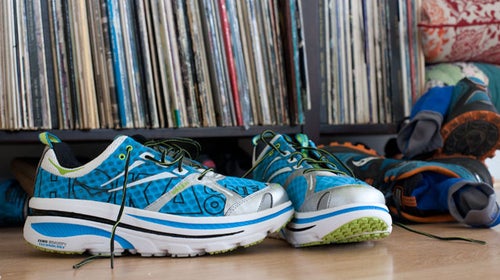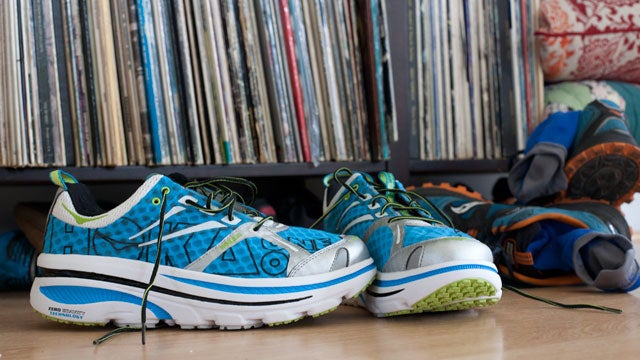A pair of ($160) have been sitting unused, sadly looking at me from my living room, for over a month now. When I pass them up on my daily run I try not to look at the 29 mm soled oversized—some call it maximalist—shoes in the same manner you would ignore your dog when you know you have to leave it behind. I know I should give them a shot. We gave the Hoka One One Conquest Gear of the Show at Outdoor Retailer this summer and I have heard anecdotally that they are a game changer for injury prevention.
There’s one problem. “They might be the best shoes in the world, but I would not be caught dead in them,” ultra-running legend Jenn Shelton told me on a run yesterday. “And you wanna know why? They are not sexy.”
And, while I’m not after sexy, I have to admit the the giant soles make them look clown shoe-y and it is vanity that have kept them off my feet.
Last weekend I paced Shelton at the Pine to Palm 100 in Ashland, Oregon and I saw three of the top seven competitors wearing them at the aid station where I waited for her. I was intrigued, but before actually running in them—outing myself as maximalist curious—I had to be sold.
The idea for the first Hoka One One shoe came from ultra runner Nicholas Mermoud approaching previous president of Salomon Jean-Luc Diard about five years ago asking for help designing a shoe that ran well down hill. Diard had been toying with the idea of oversized soles because of the popularity of fat tennis rackets and golf clubs and more recently skis. According to Hoka One One President Jim Van Dine, Diard had no intention of improving on existing shoes, he started with a totally clean slate as if no running shoe had been invented before.
The team had a strong foundation in ski as well as shoe design which resulted in a focus on shaping the sole, like how designers shape skis or surfboards. And while their massive soles are the most noticeable feature, Van Dine says they are only 25-30 percent of the story. The rockered midsole is also key to their performance. Taking note that the fastest marathon times have been set on wheelchairs, Diard set out to design a shoe that could roll.
“Rocker design involves a rounded forefoot combined with a stiff, inflexible forefoot, the combined effect allows for a more efficient rolling motion and push for propulsion,” says Van Dine.
The lightness of these shoes is an astounding feature. The Bondi Bs in my living room only weigh 11-ounces. This is mainly thanks to the foam. Even though there is a ton of it, the foam is very low density compared to traditional running shoes.
But how do they run? I asked Hoka One One athlete and recent winner of the Run Rabbit Run 100 in Steamboat, Jason Schlarb, to make his case for the oversized shoes and was surprised to find that he struggled with embarassment wearing them in the beginning as well. “For me, they looked goofy,” says Schlarb. In order to give them a chance, he decided to give them a scientific test. He ran the same designated loop five times a week—twice with the minimalist shoe he had been previously training with and three times with Hoka One Ones.
“I was a little bit more comfortable and a little bit faster [in the Hokas],” says Schlarb. “But, my legs were way fresher.”
Schlarb claims that thanks to the massive shock absorption in the soles, he has not sustained an injury that has kept him from running in the two years he has trained in the oversized shoes. His previous career record for remaining injury free was six months. Hoka One One claims the soles are up to 35% wider than a traditional shoe, which makes them stable. “It is like being on a monster truck,” says Schlarb.
And with that, I was sold. I will strap them on for my long run this weekend. If the kids in Lithia Park find ways to ridicule me I will remember that their words can’t hurt me as much as repeated impact. Expect to see a long form review in a month.


